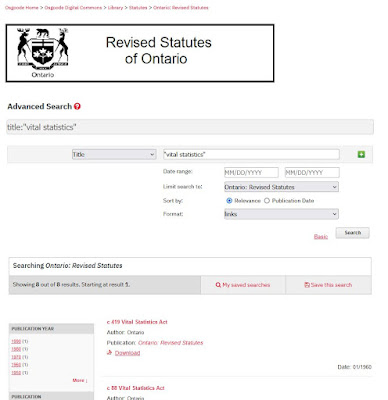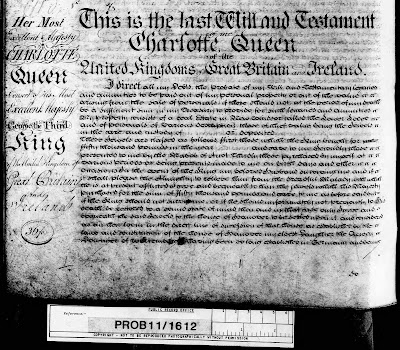
Up until January 6, 2025, the only place you could view the 1921 censuses of England, Wales, Channel Islands, and the Isle of Man from home was Findmypast. This census had been released on the Findmypast site in January 2022. However, to access that census from home, one either had to have what Findmypast currently calls their "Everything" subscription or pay either for the transcription or to see the images associated with a household on a per household view. That all changed earlier this year when Ancestry added that 1921 census to their catalogue since Findmypast no longer had the exclusive rights to host the images online.
Before we look at this census on Ancestry, it might be a good idea for folks to first read the Findmypast blog page "The 1921 Census is now online for the very first time" and also follow the links on Findmypast's help page "The 1921 Census of England & Wales" as a refresher to understand what was captured and how it was taken. I'll let you read it yourself. When that census was released online in 2022 there was also a flurry of blog posts writing about it such as John Reid's "1921 Census Experience" on Anglo Celtic Connections.
However, before jumping into the images on Ancestry, I want to highlight a few things:
The first issue with this census is that it wasn't taken on Sunday, April 24, 1921 like what it written on all the forms. Due to the "industrial crisis" (mass strikes!) happening at the time, the census had been postponed until June 19, 1921. Of course this can throw a wrench into finding your kin since they may have already started their holidays a bit early. That happened to me with one of my distant cousins.
The next is that this census, unlike the 1950 census of the USA and 1931 Census of Canada which were transcribed using AI enhanced handwriting recognition technology, was transcribed by humans. That is why it took about six months for it to be published with a searchable index on Findmypast instead of the days we are now seeing on Ancestry for newly released censuses.
Finally, when you viewed the image of the census page with the folks listed at an address on Findmypast, you also had the option to view the "Extra" images associated with that page:
- "Cover" of the enumerator's book
- "Address", which was written on the other side of the page that had all the details about who resided at that location. The "address" included details to help one to create a "good" citation.
- "Map" showing the big picture of the area to be enumerated
- "Plans of Division" that describes that enumerator district
Findmypast made it easy for us to access all those extra images. If you retrieved the image of the page with the people at a place from Findmypast, hopefully you also downloaded the extra images to your computer for safekeeping and later review.
But what it you didn't spend the money from your genealogy budget (yes, I have a budget for my research) on either the "Everything"subscription on Findmypast or buying access to the individual images? Maybe you only purchased the right to view the transcription on Findmypast and didn't pay to view the image.
Well, if you have a subscription with Ancestry that includes the censuses of England, you now have access to the transcriptions and images without paying extra.
Yet like most of our genealogy and family history research, there are a few gotchas with using the census on Ancestry:
The first is there currently isn't a single search page on Ancestry for the 1921 census for England, Wales, Channel Islands, and Isle of Man like we found on Findmypast. But we can use the existing "UK Census Collection" search page like I show here to search for Harry Warrener. I used the "Residence Date" search box at the bottom of the form to limit the search to exactly 1921 (highlighted in a red oval).
 |
Screen capture of Ancestry's "UK Census Collection" search page looking for Harry Warrener with a Residence Date of exactly 1921, taken 14 Jan 2025.
|
By doing this, you can easily search the individual Ancestry 1921 census collections of
- 1921 Channel Islands Census
- 1921 England Census
- 1921 Isle of Man Census
- 1921 Wales Census
all in one go.
The next thing to understand is the source of the transcription used to create the searchable index.
Here I've recreated the search I used to find the page with the enumeration of Annie Leontine Chipman. I know we should treat each person in our tree equally but Annie has become a favourite of mine just due to the interesting life she led, challenges she presented me in finding her in the records, and what some of those records have taught me in terms of how they were created (Annie Leontine Chipman and a Census Mystery).
 |
Screen capture of Findmypast's 1921 Census of England & Wales search results for Leontine Chipman, taken 14 Jan 2025.
|
Here are the results of the same query on Ancestry:
 |
| Screen capture of Ancestry's UK Census Collection search results for Leontine Chipman with a residence date of exactly 1921, taken 14 Jan 2025. |
Everything seems to be same. My guess is that Findmypast, as part of their agreement with The National Archives (TNA) in England, has given TNA the transcriptions and Ancestry is using those transcriptions instead of creating their own.
Why do I think that?
 |
| 1921 census of England, Devonshire, Coombe House, St. George's Road, Torquay, extract; digital images, Findmypast, Findmypast (www.findmypast.com : accessed 30 Jul 2024); citing RG 15/10483 Sch 53, registration district 272, sub district 6, enumeration district 31. |
In looking at the entry for Leontine Chipman on the image of the occupants of "Coombe House" on St. George's Road in Torquay, Devon we can clearly see that the birthplace for Leontine is "Cornwallis Nova Scotia". I'm suspecting the transcriber tried to fit a square peg in a round hole and selected "Cornwall, England" from a drop down box.
In a chat with John Reid, he asked Gemini what was written in that box in the image and Gemini came back with:
"The image appears to say:
Cornwallis
Nova Scotia
Let me know if you have any other images you need transcribed!"
This transcription error made it a bit of a challenge to find her initially since she should have been in Northumberland County, England instead of holidaying in Devonshire. I had initially discounted that index entry since it stated Cornwall and not Nova Scotia or Canada as her birth place. If it hadn't been for the kindness of a stranger who had a full subscription with 1921 census access on Findmypast to quickly check the image from the record for me I would never have found her. But this quirk also seems to indicate that the transcriptions on Ancestry originally came from the work done by Findmypast.
When it comes to viewing the images on Ancestry, if we want to see almost all the same images that are pointed to on Findmypast, we need to do a bit of work ourselves.
 |
| Screen
capture of the top part of Ancestry's page from the 1921 England Census for Leontine Chipman, taken 14 Jan 2025. |
When we look at the details page for Leontine Chipman and click on the image shown, we are brought to the page in the census with the details recorded for everyone at the location as of midnight 19 Jun 1921.
To view the other side of that page with the street address, registration district number, registration sub-district number, and enumeration district number we need to go to the next image. On Findmypast, this is the image they labelled as "Address".
If you are like me and save any of the images you find about your kin to your computer, make sure you also save this one too.
You will also probably want to go to the first image of the image filmstrip for that Enumeration district to get the other details about the enumeration district and also the "series piece number" for your source citation. The series piece number is the number after the RG15 that was written on the page when it was archived at The National Archives.
 |
Cover page for Registration District 272, Registration Sub-district 6, Enumeration District 30 & 31 with the RG and Series Piece Number written on the page.
|
What about the "Plan of Division" pages that were linked to on Findmypast? They are from RG114 at The National Archives. That takes a bit more effort to locate on Ancestry since they are stored a bit differently. On Ancestry we need to browse the images, pick the county we are interested, select the appropriate name of the registration district, and then select "Not Stated" as the Sub-registration district.
In the case of where Leontine was residing when the census took place, on that "Cover" page from the enumerator's book, we can faintly read "Newton Abbot" beside the number 272 as the registration district. Next we need to walk through the images to find the "Plan of Division" page for 272 number 6. On Ancestry's filmstrip, that was found on image 203 of 278. Finally we want to location the page for Enumeration District 30 and 31 which is located on images 255 and 256 where we learn the boundary descriptions of those two enumeration districts.
As for the maps of the registration districts provided by Findmypast as one of the "extra" images, those appear to be from The National Archives RG 18 (https://discovery.nationalarchives.gov.uk/browse/r/h/C16337741) but they don't seem to have been added to the Ancestry collection for the 1921 census. Using The National Archives site I as able to quickly browse through the descriptions to location registration district 272 to find that RG 18/1103 is a "Collage of Ordnance Survey map sheets cut, mounted and annotated to show the following registration districts as used for the 1921 census...District 272, sub-district 6: Torquay" (https://discovery.nationalarchives.gov.uk/details/r/C990371). Alas, I've also not been able to find these maps on sites other than Findmypast. So if you know of a site with the TNA RG 18/830-1465 collage of maps, please let me know!
Hopefully with the information I've provided, you will be able to better document in your tree on Ancestry all your kin who were in England, Wales, Channel Islands, or Isle of Man when that 1921 census was taken.
Have fun in your noble quest to learn more about your family lines!




















 In our genealogy and family history research we've all probably come across challenges with finding someone in the records when searching for them by their name. The issue could be a problem with the transcription used to create the index such as what I found for the household of Thomas S. Pattillo inthe 1911 Census of Canada where the surname was originally transcribed as "Pattires" by the folks at Ancestry.
In our genealogy and family history research we've all probably come across challenges with finding someone in the records when searching for them by their name. The issue could be a problem with the transcription used to create the index such as what I found for the household of Thomas S. Pattillo inthe 1911 Census of Canada where the surname was originally transcribed as "Pattires" by the folks at Ancestry.![Extract from the 1911 Census of Canada, Nova Scotia, Colchester, Truro, p 13 of the Thomas S. Pattires [Pattillo] household](https://blogger.googleusercontent.com/img/b/R29vZ2xl/AVvXsEinvBY1kieeZ_DDxuYuY-OsT_csfUREw5InjANohdEFqIPoGENMaILpfUz4KuVhqghNNzAIfaqMq_HXppK4FiXtIPVQsdOzGV-_jk-4q1tghxl4rDT8-0CYFDawdJ7JeUoK-9vYEykUUKV4omiFVtnAtySNOScw_FS8WFaPrNOZiUtAuqPByUmVwNL3btw/w400-h113/Blog%20-%201911%20Census%20of%20Canada,%20Nova%20Scotia,%20Colchester,%20Truro%20(25),%20p%2013%20-%20Thomas%20Pattires%20(Pattillo)%20household%20extract.jpg)
,%20Division%202,%20p%2061%20-%20Household%20of%20John%20Hutton.jpg)











